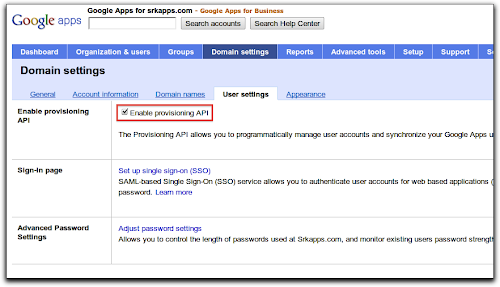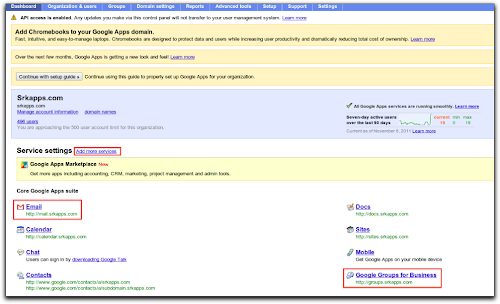Wednesday, March 11, 2015
Managing groups using the new Groups Settings API
The recently launched Groups Settings API allows Google Apps domain administrators to write client applications for managing groups in their domain. Once you have created the groups and added members using the Provisioning API, you can use the Groups Settings API to perform actions like:
- manage access to the group
- configure discussion archiving
- configure message moderation
- edit a groups description, display format and custom fields
Let’s have a look at how you can make authorized calls to the Groups Settings API from your client application.
Getting Started
You must enable the Provisioning API to make requests to the Groups Settings API. You can do so by enabling the Provisioning API checkbox in the Domain settings tab of your Google Apps control panel.

Next, ensure that the Google Groups for Business and Email services are added to your domain by going to the Dashboard. If these services are not listed, add them by going to Add more services link next to the Service settings heading.

Now you are set to write client applications. Lets discuss the steps to write an application using the Python client library. You need to install the google-api-python-client library first.
You can register a new project or use an existing one from the APIs console to obtain credentials to use in your application. The credentials (client_id, client_secret) are used to obtain OAuth tokens for authorization of the API requests.
Authorization using OAuth 2.0
The Groups Settings API supports various authorization mechanisms, including OAuth 2.0. Please see the wiki for more information on using the library’s support for OAuth 2.0 to create a httplib2.Http object. This object is used by the Groups Settings service to make authorized requests.
Make API requests with GroupSettings service
The Python client library uses the Discovery API to build the Groups Settings service from discovery. The method build is defined in the library and can be imported to build the service. The service can then access resources (‘groups’ in this case) and perform actions on them using methods defined in the discovery metadata.
The following example shows how to retrieve the properties for the group staff@example.com.
service = build(“groups”, “v1”, http=http)
group = service.groups()
g = group.get(groupUniqueId=”staff@example.com”).execute()
This method returns a dictionary of property pairs (name/value):
group_name = g[name]
group_isArchived = g[isArchived]
group_whoCanViewGroup = g[whoCanViewGroup]
The update method can be used to set the properties of a group. Let’s have a look at how you can set the access permissions for a group:
body = {whoCanInvite: ALL_MANAGERS_CAN_INVITE,
whoCanJoin: ‘INVITED_CAN_JOIN’,
whoCanPostMessage: ‘ALL_MEMBERS_CAN_POST’,
whoCanViewGroup: ‘ALL_IN_DOMAIN_CAN_VIEW’
}
# Update the properties of group
g1 = group.update(groupUniqueId=groupId, body=body).execute() Additional valid values for these properties, as well as the complete list of properties, are documented in the reference guide. We have recently added a sample in the Python client library that you can refer to when developing your own application. We would be glad to hear your feedback or any queries you have on the forum.
| Shraddha Gupta profile Shraddha is a Developer Programs Engineer for Google Apps. She has her MTech in Computer Science and Engineering from IIT Delhi, India. |
No comments:
Post a Comment
Note: Only a member of this blog may post a comment.